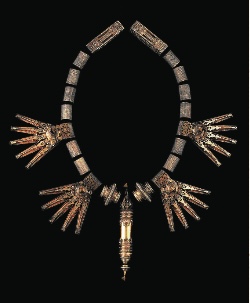BY LAVINA MELWANI
Gold is almost a language in India. It speaks of birth and marriage, of rituals and devotion. It’s a shimmering ode to the Almighty and to the many celebrations of an ancient civilization.
Adornment in India, however, is not just for the Gods or the wealthy. Everyone, from a newborn babe to a bullock in the fields, is bedecked with beauty. Even the auto rickshaw is a decorated work of art!
Noted New York collector Susan L. Beningson knows this well. She has long had a love affair with India and owns a treasure trove of Indian jewelry from the 17th, 18th and 19th centuries. Over 150 pieces of this art are featured in When Gold Blossoms: Indian Jewelry from the Susan L. Beningson Collection now showing at The Asia Society in New York. The show spotlights the intricate beauty and the technical craftsmanship of gold jewelry from South India.
Beningson has been to India several times and visited many temples, especially in South India. “As you can see, my interest is much more in South Indian jewelry than in Mughal ornaments, ” she says. “Personally, I feel the most meaningful are the temple objects that were placed in shrines. There’s something about the temple jewelry–jewelry made for the Gods–that I find very special.”
I asked her if seeing art like that changed her perspective on jewelry. “Of course. I think it has to, ” she replied. “Just thinking how the objects were used in context–why they would bejewel the Deity, to begin with. It’s just a very different way of looking at religion–more interactive.”
Walk through the exhibition and you see that gold is very much a part of Indian life. There are gold earrings, necklaces, rings, braid ornaments, forehead pendants, nose rings and bracelets.
As Molly Emma Atkins, curator of the show, observes, “When you step in here, you are just overwhelmed by how beautiful it is. What one forgets is how meaningful these pieces are in society in a religious context, in a social context.”
The jewelry from South India is distinctive. “Like much South Indian jewelry, ” says Atkins in explaining the design of a pair of gold earrings carved as two rearing cobras, “these pieces combine natural forms with architectural geometry.”
The high point of most South Indian weddings is the tying of the marriage pendent, or the tali. The tali not only shows that a woman is married, the style of its execution reveals her origin, as well as her chosen Deity of worship.
Perhaps no humans have a more intense relationship with their Gods than Hindus. They name their children after Gods. They emblazon their homes with images of God. And yes, Krishna, Siva and Lakshmi are entwined on their necks, their arms and in their hair. They are enveloped by God!
The Divine is so much a part of people’s lives that Gods and Goddesses turn up on all sorts of adornment objects: a pair of exquisite gold earrings, possibly from the 16th century, bear images of the Goddess Lakshmi illustrated with elephants. Explains Aitkens: “Lakshmi, the Goddess of wealth and good fortune, is strongly associated with gold. Her icon on these earrings expresses the essence of wifehood: that a beautifully adorned wife who models herself on Lakshmi will bring prosperity to her home.”
A gold pendant and earrings from South India show Krishna playing the flute and dancing on Kaliya; the pendant also has Vishnu dancing on a snake. Ask Aitkens about the propriety of wearing the image of Krishna on a hair braid, and she says, “One aspect of Hinduism is the informal relationship devotees have with God. The most intense devotion is a personal devotion, and Krishna is an amorous God that you are invited to approach as a lover. So the idea that He is in your hair and blessing your beauty is entirely appropriate.”
Another pendant in the exhibit is set with rubies and crystal and shows Siva and Parvati on Nandi, Siva’s bull vehicle. Aitkens says this 17th-century piece probably was worn around the neck, as a private shrine. “Personal devotion focused on a devotee’s intimate relationship with her or his Deity, a relationship unmediated by texts, priests or rules. Here, Siva and Parvati are kept close to the heart.”
The Susan L. Beningson Collection is also rich in temple gold and devotional jewelry, including items given to temples or personal shrines. Browse the displays and you are amazed at the way gold has been used as a metaphor for man’s highest aspirations.
Devotees offered the most beautiful jewelry to their Gods–crowns, armbands and jeweled sandals–and placed them on silver swings. Some of the remarkable pieces include a silver gilded swing from the 18th century with peacocks perched on it. The seat of the swing is shaped like a throne for Krishna.
In the collection there is a pair of tiny Deity sandals made of sheet gold and embedded with rubies, diamonds and pearls. There are also gold accoutrements for a Krishna shrine–an umbrella, some rattles, a peacock and parrots–all playthings for Baby Krishna.
Hindus believe that Deities actually enter the icons that they lovingly place in their home shrines. For this reason, they treat these physical forms as honored guests, feeding, bathing, dressing and decorating them with jewels and silks.
After touring this exquisite exhibit, one realizes the very special relationship that exists between God and the Hindu devotee. Indeed, this beautiful collection shows a constant interweaving of the sacred with the secular. It’s almost like a powerful, mystical chant is embodied right into the physical substance of the jewelry.


